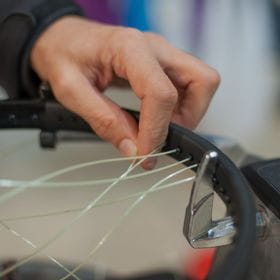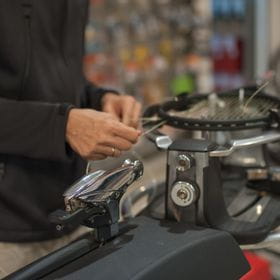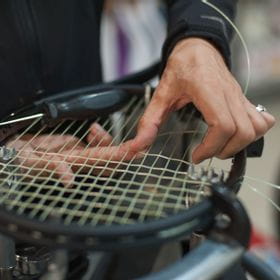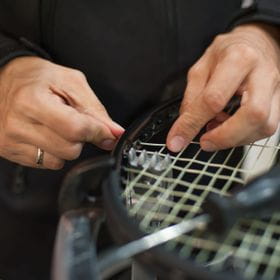How important is it to restring the racket?
Tennis Know-how
Be honest –when was the last time you had your tennis racket restrung? Today, tennisexpert Mario Schoibl gives us an insight into the artof correct restringingand explains why it can be a game-changing factor.
Categories:
Know-how
Hi, Mario! It’s great that we’re able to have a glimpse into your workshop. First of all,the question of all tennis questions: How often should you have a racketrestrung?
To that, my question is: How often do you play tennis? A rule of thumb here is that you should have your racket restrung as many times per year as you play a week. So if you play three times a week, you should have it restrung three times a year. That only applies to amateur players, however. Experienced tennisplayers have their rackets restrung by me every two weeks or so, and tournament players even more frequently, and before every tournament too, in any case. How often restringing is necessary also depends on the string used and the basic configuration of the racket.
Why is restringing really so important and how do I know when I should have my racket restrung?
You can easily imagine that the tension decreases as a result of the hits. After all, the strings are not rigid, but rather yield a little. In addition, tennis racket strings are also subject to completely normal material fatigue. Heat, cold and incorrect storage do the rest. Restringing is necessary when the tension is noticeably reduced and the quality of hitting declines. Problems in the arm scan also then occur. Finally,the string will break at some point. If you want to retain your playing strength and have a match-changing advantage, you hence cannot get out of having your racket restrung in good time.

Ok, that makes sense. Can you explain to me, using your workshop equipment, how a tennis racket is restrung?
The same steps are always taken duringrestringing:
1.First, the racket is mounted on the stringing machine and the desired tension is set.
2.The old strings are then removed. Starting from the middle, I always cut a main (vertical string) and a cross (horizontal string) alternately, so that the tension decreases evenly and no damage occurs to the frame of the racket.
3. Every racket has a particular stringing pattern, which I note.
4. Now I measure the length of the new string according to the size and the stringing pattern and cut the required string length.
5. If I am restringing the racket, I begin with the main in the middle and work outwards to the left and the right by using the clamps and the tensioning mechanism.
6.When the mains are finished, you begin with the crosses, always stringing them alternately over and under the mains. They ends of the string are knotted in the frame. And you're done!
That looks pretty complicated. Is it possible to do it yourself, and if so, what sort of tools do you need?
Yes, in principle you can string a tennis racket yourself. It is, however, fairly complex –you need a stringing machine and a great deal of experience and skill. In addition to the machine, which you also have to maintain, of course, you require two clamps, an awl, so that you can thread the piece of string through the grommets in the frame, and flat-nose pliers or needle-nose pliers as an additional aid. You can remove the old string with a string cutter, a pair of sharp scissors or even with a knife. But the correct technique is also important here, otherwise the frame will break, and you may aswell throw the racket away.
Insider tip! If you have your racket restrung nine times at Bründl Sports, the tenth time will be free of charge.
Oh ok, so perhaps it would be better if I came to you right away? What do you do when I bring you my tennis racket – how do you know what sort of restringing would suit me?
There are a number of things that a professional in stringing bears in mind. First of all, I take note of your height, weight and training regime. An amateur player weighing 50 kilograms with delicate hands of course needs different stringing from awell-trained tournament player measuring two metres. I ask how often you play, about your playing strength and your expectations. For experienced players, you can experiment with various strings, and see what the customer likes when they play. There is often a recommended tension strength indicated on the racket itself, and I can follow this, too.
You said that there are various strings? I’ve also heard that there are different knots. What’s the reason for that?
Yes, there are strings made of plastic and strings made of natural materials, just like for a harp or other instruments, actually. And the durability is also similar. Synthetic strings last longer and are more stable, but experienced players and professionals often use natural strings. You simply have to try the strings out and find out what suits you best. Some players prefer hybrid stringing, which means that the mains and crosses are different. As regards to the knots, I can string the entire racket with a single piece of string and then have a start knot and an end knot, i.e. two knots in total. If I string the mains and crosses separately, I obviously have four knots. I prefer to string rackets using two knots, but I prefer to play with a racket that has four knots (he laughs)! But that’s also something that you just have to try out yourself.

What is the advantage to having my racket strung by you, rather than taking up the pliers and string myself?
The major advantage of having your tennis racket strung by a professional, I would say, is: you simply lack the experience. We carry out this work every day, can gauge what a player needs, and are always up to date as far as technology and materials are concerned. Additionally, we exclusively use electronic machines, which are maintained regularly, of course.This means that we can always measure the tension using the same machine and we obtain reliable values. In this way, we can provide even the most demanding of players with the best advice regarding stringing a racket and gradually work towards the optimum result for successful play.
Dear Mario, thank you very much for the interview! I’ll bring my racket over to you again soon.




Mathaeus-Gartner.jpg)